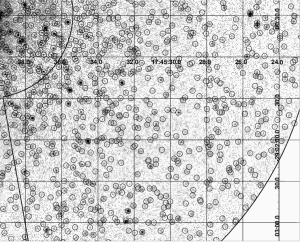 |
|
Fig. 1:
Image of the Galactic Center region taken by the Chandra
observatory. Circles denote the positions of detected point sources.
|
 |
 |
|
Fig. 2:
Luminosity functions of faint X-ray sources measured in the
Solar vicinity (red area) and in the Galactic Center region (gray
area). It can be seen that they are quite compatible with each
other. The sources in the gray area explain at least 40-50 % of the
total X-ray flux measured in the Galactic Center region, while still
weaker sources expected to be present in this region by analogy with
the Solar neighborhood, probably provide the remaining 50-60% of the
total flux.
|
|  |
It has been known since the late 1970s that apart from bright X-ray
point sources (mostly neutron stars and black holes in binary
stellar systems) there is an unresolved X-ray emission distributed
throughout the Milky Way. The origin of this "Galactic ridge X-ray
emission", or the Galactic X-ray background, remained unclear for a
long time. Numerous studies showed this emission to be strongly
concentrated towards the Galactic plane. However the measured X-ray
spectrum indicated that the emitting plasma is so hot (kT>5-10 keV)
that it cannot be bound within the Galactic gravitational well. The
plasma must then be constantly outflowing and carrying away an
enormous amount of energy, the source of which was not understood.
An alternative explanation of the Galactic X-ray background,
proposed soon after its discovery, is that it is the superposition
of X-rays from millions of Galactic point sources, too weak to be
detected individually. This would eliminate the problem of keeping
hot plasma bound to the Galactic plane. However it was difficult to
rigorously test this hypothesis because there was a large
uncertainty with regard to the expected cumulative luminosities of
different classes of faint Galactic X-ray sources.
MPA reseachers have recently made a number of steps that
significantly furthered our understanding of the contribution of
point sources to the Galactic X-ray background (see
 Research Highlight March 2006
Research Highlight March 2006
 Research Highlight April 2006
Research Highlight April 2006
 Research Highlight August 2006
). However the ultimate answer as to whether the Galactic X-ray
background is produced by point sources or by truly diffuse
interstellar plasma can only be given by direct observations. The
most suitable tool for this purpose is the Chandra X-ray
observatory. This is because the angular number density of X-ray
sources becomes so high at low fluxes that one needs arcsecond
angular resolution (as provided by Chandra) to overcome the problem
of source confusion.
Research Highlight August 2006
). However the ultimate answer as to whether the Galactic X-ray
background is produced by point sources or by truly diffuse
interstellar plasma can only be given by direct observations. The
most suitable tool for this purpose is the Chandra X-ray
observatory. This is because the angular number density of X-ray
sources becomes so high at low fluxes that one needs arcsecond
angular resolution (as provided by Chandra) to overcome the problem
of source confusion.
Mikhail Revnivtsev and Sergey Sazonov from MPA and Alexey Vikhlinin
from CfA-Harvard (USA) used approximately 1 Msec worth of Chandra
observations of the Galactic Center region to demonstrate that point
sources with X-ray luminosities higher than 1031 erg/s contribute
at least 40% to the total X-ray background in this region.
Furthermore, a comparison of the reconstructed luminosity function of
Galactic Center point sources with the previously measured
luminosity function of X-ray sources in the Solar neighborhood
showed very good agreement between the two and suggested that the
still unresolved 60% of the Galactic X-ray background is probably
produced by coronally active stars and white-dwarf binaries with
luminosities below 1031 erg/s, the current effective threshold of
Chandra.
Mikhail Revnivtsev, Sergey Sazonov
|



